Nuremberg 1896 (July 20-August 10, 1896)
The chess world in 1896
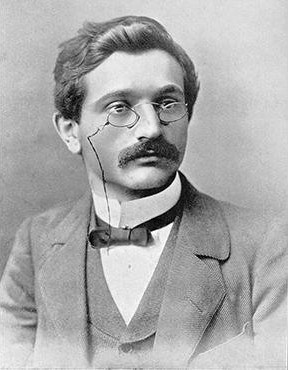 Lasker had been reigning for two years as world champion in 1896 after a rather meteoric rise. In a span of five years from his first tournament in the Sixth German Congress in 1889, and his first international appearance in Amsterdam in 1892, he defeated Wilhelm Steinitz in the world championship match of 1894 staged in the North American cities of Philadelphia, Montreal and New York.
Lasker had been reigning for two years as world champion in 1896 after a rather meteoric rise. In a span of five years from his first tournament in the Sixth German Congress in 1889, and his first international appearance in Amsterdam in 1892, he defeated Wilhelm Steinitz in the world championship match of 1894 staged in the North American cities of Philadelphia, Montreal and New York.
Lasker (pictured) was a huge underdog against the experienced champion who had defeated Johannes Zukertort, Mikhail Chigorin, and Isidor Gunsberg in the previous four world championship matches. Lasker defied expectations, but failed to convince the skeptics. Siegbert Tarrasch dismissed the match as one that Steinitz lost than Lasker had won, saying: “The old Steinitz is no longer the Steinitz of old”.
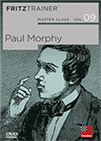 Learn about one of the greatest geniuses in the history of chess! Paul Morphy's career (1837-1884) lasted only a few years and yet he managed to defeat the best chess players of his time.
Learn about one of the greatest geniuses in the history of chess! Paul Morphy's career (1837-1884) lasted only a few years and yet he managed to defeat the best chess players of his time.Lasker was untested in a super tournament. In his first one, Hastings 1895, held in August to September that year, he could only finish third behind Harry Nelson Pillsbury and Mikhail Chigorin. Pillsbury’s victory pushed him into title contention.
Tarrasch himself was a perennial contender when he proved himself the strongest tournament player, winning five successive international tournaments between 1888 and 1894. In late 1895, therefore, Lasker, Steinitz, Chigorin, Tarrasch, and Pillsbury all had a strong case of being the world’s strongest player. Excluding the world champion, the rest were genuine title contenders.
Amid the confusion, all five players were invited to participate in the great St. Petersburg Tournament that ran from December 1895 to January 1896. Tarrasch refused, but the remaining four played a tournament-match of six games among them. Lasker vindicated himself, winning the event. Steinitz wound up second to justify the rematch that he called against Lasker immediately after losing his title.

St. Petersburg Tournament 1895-96
Half a year after the St. Petersburg tournament, the Nuremberg Chess Club arranged an international tournament. The event gathered the world’s strongest players, and much was at stake for the five leading players, as well as for the rest of the participants.
The Nuremberg tournament
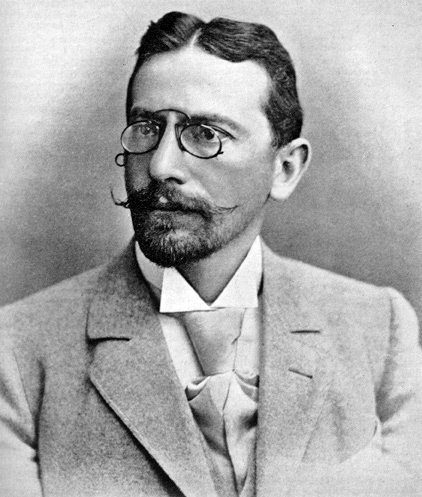 Beginning 1879, high-class German Federation tournaments became important proving grounds for aspiring players. Nuremberg 1888, Breslau 1889, Dresden 1892, and Leipzig 1894, four of the five international tournaments Tarrasch won successively, all pushed him to the forefront.
Beginning 1879, high-class German Federation tournaments became important proving grounds for aspiring players. Nuremberg 1888, Breslau 1889, Dresden 1892, and Leipzig 1894, four of the five international tournaments Tarrasch won successively, all pushed him to the forefront.
Tarrasch (pictured) himself was a member of the Nuremberg Chess Club in 1896. One of the club’s objectives for the international tournament that year was to allow him to enhance his title chances.
Tarrasch’s star had risen before Lasker’s, but in 1892 he refused a world championship match against Steinitz that the Havana Chess club offered to arrange. He was unwilling to suspend his medical practice for a long and rigorous match. Lasker himself challenged Tarrasch, but the doctor proudly declined, saying Lasker had to first win a major tournament. Lasker instead challenged Steinitz, and with his victory Tarrasch thus saw his rival pass him by. He had let slip a golden opportunity, while Lasker did not waste the one that came his way.
As had been the tradition of the times, Nuremberg 1896 was held simultaneously with a world fair, this one with the Bavarian State Exposition of 1896. The event included “everyone”. Apart from the five leading players, veterans such as Joseph Henry Blackburne, Emanuel Schiffers, and Szymon Winawer, and rising stars such as Geza Maroczy, Carl Schlechter, David Janowski, Rudolf Charousek, and Carl August Walbrodt participated.
The magazine Berliner Schachzeitung described the field:
 The name Emanuel Lasker will always be linked with his incredible 27 years reign on the throne of world chess. In 1894, at the age of 25, he had already won the world title from Wilhelm Steinitz and his record number of years on the throne did not end till 1921 when Lasker had to accept the superiority of Jose Raul Capablanca. But not only had the only German world champion so far seen off all challengers for many years, he had also won the greatest tournaments of his age, sometimes with an enormous lead. The fascinating question is, how did he manage that?
The name Emanuel Lasker will always be linked with his incredible 27 years reign on the throne of world chess. In 1894, at the age of 25, he had already won the world title from Wilhelm Steinitz and his record number of years on the throne did not end till 1921 when Lasker had to accept the superiority of Jose Raul Capablanca. But not only had the only German world champion so far seen off all challengers for many years, he had also won the greatest tournaments of his age, sometimes with an enormous lead. The fascinating question is, how did he manage that?
To the arena came the stars of the chess world: from America – Steinitz, Showalter, Pillsbury; from Russia – Chigorin, Schiffers, Winawer; from France – Janowsky; from England – Lasker, Blackburne, Teichman; from Austro-Hungary – Charousek, Schlechter, Marco, Albin, Porges, Maroczy; from Germany – Tarrasch, Schallop, and Walbrodt (July 23, 1896).
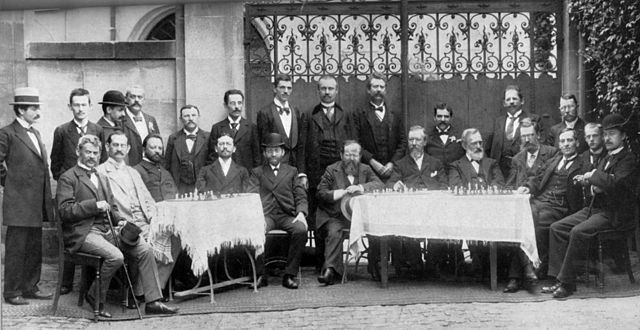
Participants of the Nuremberg 1896 Tournament
Based on modern rating estimates, the tournament’s seeding from top to bottom would have gone as follows:
| Player |
Rating |
| Emanuel Lasker |
2726 |
| Siegbert Tarrasch |
2645 |
| Wilhelm Steinitz |
2624 |
| Harry Nelson Pillsbury |
2622 |
| Mikhail Chigorin |
2618 |
| Geza Maroczy |
2596 |
| David Janowsky |
2592 |
| Rudolf Charousek |
2589 |
| Carl Schlechter |
2570 |
| Joseph Henry Blackburne |
2545 |
| Carl August Walbrodt |
2545 |
| Emanuel Schiffers |
2530 |
| Jackson Showalter |
2528 |
| George Marco |
2505 |
| Szymon Winawer |
2482 |
| Richard Teichmann |
2481 |
| Moritz Porges |
2445 |
| Adolf Albin |
2397 |
| Emil Schallop |
2337 |
Most of the players who participated in Hastings 1895 were present, and among the top ten there, only Curt von Bardeleben was missing. The German master Berthold Englisch and the Englishman Amos Burn were also invited, but they withdrew at the last minute.
Time limit was set at 30 moves in the first two hours, and 15 moves in each succeeding hour. The Museum Society of Nuremberg offered its premises and facilities as venue. Play began on July 20.
It turned out that no one could keep up with Lasker, who took the lead right from the start. After 7 rounds he had 6 points and sat in first place. He lost to Pillsbury and Janowsky between the 8th and the 10th rounds, allowing the latter to catch up with him. In the following seven rounds, however, he put up a sprint, scoring 6½ points. Although he lost in the last round to Charousek, his lead was by then insurmountable. He won the event by a one-point margin.
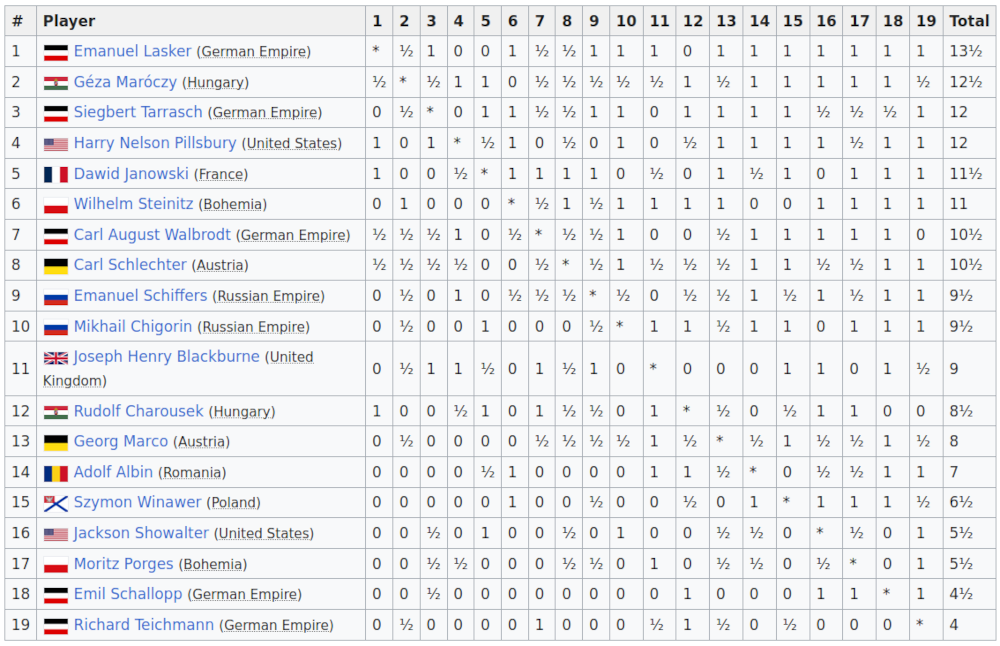
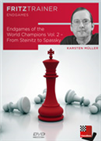 Enjoy Capablanca's fine technique, Tal's magic, Lasker's fighting spirit, Petrosian's defensive skills, Smyslov's feeling for harmony, and Alekhine's and Spassky's flair for the attack.
Enjoy Capablanca's fine technique, Tal's magic, Lasker's fighting spirit, Petrosian's defensive skills, Smyslov's feeling for harmony, and Alekhine's and Spassky's flair for the attack.After winning St. Petersburg 1895-96, Lasker’s victory affirmed his worthiness as world champion. Maroczy’s second-place finish was a surprise. He and the other young participants, for whom the tournament was a rite of passage, went on to have outstanding careers. Maroczy became one of the leading players in the early 20th century, while Janowski and Schlechter played world championship matches with Lasker himself in 1910.
Tarrasch perhaps remained the only one unconvinced of Lasker’s superiority. He published a tournament book with an extraordinary “table of fortune”. The table displayed which of the top ten prize winners were able to win drawish or losing games through sheer accidental good fortune. Lasker topped the table! It revealed Lasker scored five points in games he should have drawn or lost against Albin, Schallop, Schiffers, Showalter, and Chigorin. Tarrach may not have yet appreciated Lasker’s resourcefulness and his adeptness at the practical and psychological aspects of the game. Lasker would grow enormously strong, and with these same fighting qualities he would hand Tarrasch a lopsided defeat in the 1908 World Championship Match.
By virtue of his 2nd-place finish in St. Petersburg, Lasker granted Steinitz a rematch, which began in November 1896 in Moscow. Steinitz’s 6th-place finish in Nuremberg must have foretold his chances, for he lost the match even more lopsidedly than the first, 10-2.
Pillsbury never repeated his remarkable performance in Hastings 1895. He remained a top competitor and a perennial title contender up to the 20th century, but syphilis would tragically take his life away in 1906 at the age of thirty-three.

Harry Nelson Pillsbury
Chigorin, the most senior of the five leading players, would perform strongly up to the early 20th century. He passed away in 1908. With his immense influence on Russian chess, he would serve as an inspiration to Soviet players who would come to dominate the chess world in the middle and latter parts of the 20th century.
With events such as Hastings 1895, St. Petersburg 1895-96, and Nuremberg 1896, tournament chess reached its apex. Nuremberg 1896, in particular, gathered the world’s leading players. It provided a battleground for Lasker, Steinitz, Chigorin, Tarrasch, and Pillsbury, who were then jostling for supremacy. Lasker’s victory affirmed his worthiness of the chess crown, and ushered in his finest years as world champion. Nuremberg 1896 also introduced young, outstanding players such as Maroczy, Janowski, and Schlechter who were soon to make their mark in chess history.
References
Games
Here are six classics from Nuremberg 1896. These are the best games of the five leading players — Lasker, Steinitz, Chigorin, Tarrasch, and Pillsbury — and a brilliant one from the irrepressible Janowski.
Pillsbury vs. Lasker - Round 9 (July 29)
Pillsbury plays a rook sacrifice. There is no knock-out blow, but Pillsbury assesses correctly that his attack is decisive in all the ensuing variations. The game won the tournament's brilliancy prize.
Porges vs. Lasker - Round 1 (July 20)
Lasker shows he is far ahead of his times by demonstrating Nimzovitsch’s principles. Black comes out somewhat restrained in the opening, but Lasker unleashes his position’s pent-up potential. He breaks free and finds successive time-gaining moves that lead to a neat mating attack.
Tarrasch vs. Charousek
Tarrasch’s strong flank attack makes short work of Charousek.
Steinitz vs. Marco - Round 11 (July 31)
Steinitz centralizes beautifully, then delivers a methodical king-side attack.
Chigorin vs. Albin - Round 13 (August 3)
Chigorin, known for his tactical abilities, shows excellent positional skills. Achieving a dominant position where Black has no shred of counterplay, he bides his time and breaks through gradually.
Janowski vs. Schallop - Round 9 (July 29)
Janowski plays a powerful attacking game with incredibly beautiful tactics.
Links
.jpeg)

















 Lasker had been reigning for two years as world champion in 1896 after a rather meteoric rise. In a span of five years from his first tournament in the Sixth German Congress in 1889, and his first international appearance in Amsterdam in 1892, he defeated Wilhelm Steinitz in the world championship match of 1894 staged in the North American cities of Philadelphia, Montreal and New York.
Lasker had been reigning for two years as world champion in 1896 after a rather meteoric rise. In a span of five years from his first tournament in the Sixth German Congress in 1889, and his first international appearance in Amsterdam in 1892, he defeated Wilhelm Steinitz in the world championship match of 1894 staged in the North American cities of Philadelphia, Montreal and New York.
 Beginning 1879, high-class German Federation tournaments became important proving grounds for aspiring players. Nuremberg 1888, Breslau 1889, Dresden 1892, and Leipzig 1894, four of the five international tournaments Tarrasch won successively, all pushed him to the forefront.
Beginning 1879, high-class German Federation tournaments became important proving grounds for aspiring players. Nuremberg 1888, Breslau 1889, Dresden 1892, and Leipzig 1894, four of the five international tournaments Tarrasch won successively, all pushed him to the forefront.







